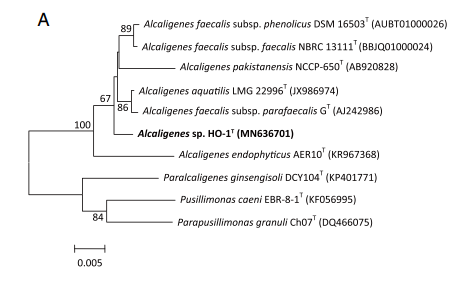Alcaligenes ammonioxydans: Difference between revisions
| Line 23: | Line 23: | ||
=16S Ribosomal RNA Gene Information= | =16S Ribosomal RNA Gene Information= | ||
''Alcaligenes ammonioxydans'' forms a cluster with other ''Alcaligenes'' isolates that is clearly separate from ''Alcaligenes faecalis'' but is still closely related (Wu et al. 2021) | |||
[[File:HO-1_phylogenetic_tree.png|right|thumb|500px|Neighbour-joint phylogenetic tree of strain HO-1 with its closely related type strains within the genus ''Alcaligenes''. Outgroups were chosen based on similarity to HO-1 (>96%) and are ''Paralcaligenes ginsengisoli'' DCY104, ''Pusillimonas caeni'' EBR-8-1T and ''Parapusillimonas granuli'' Ch07T. Genebank accession numbers of 16S rRNA gene sequences are given in parentheses (Wu et al. 2021)]] | |||
=Genome Structure (if the genome exists)= | =Genome Structure (if the genome exists)= | ||
Revision as of 15:30, 17 April 2023
Classification
Higher order taxa
- Domain: Bacteria
- Phylum: Proteobacteria
- Class: Beta Proteobacteria
- Order: Burkholderiales
- Family: Alcaligenaceae
- Order: Burkholderiales
- Class: Beta Proteobacteria
- Phylum: Proteobacteria
Species
Species
- Genus: Alcaligenes
- Species: ammonioxydans
Alcaligenes ammonioxydans sp. nov. strain HO-1
Description and significance
The Genus Alcaligenes is composed of Gram negative, typically aerobic species that have a wide range of metabolic capabilities, which included heterotrophic nitrification-aerobic denitrification (Hendrie et al. 1974; Wu et al. 2021). Alcaligenes ammonioxydans sp. nov. HO-1 was first isolated from the active sludge of a SHARON bioreactor of a combined system which was used to treat wastewater from pig husbandry (Wu et al. 2021) This species is capable of high amounts of ammonia removal, and without optimization was capable of removing 195.59 mg/L NH4 per day on 28mM NH4.. A. ammonioxydans grew aerobically and achieved ammonia removal on a range of carbon substrates which include acetate, ethanol, propionate, malate, succinate, and citrate and on C/N ratios ranging from 2-20. Optimal pH is 7 but growth is observed at range from 6-10, and optimal temperature is 30°C with growth seen at 23-37°C (Wu et al. 2021)
16S Ribosomal RNA Gene Information
Alcaligenes ammonioxydans forms a cluster with other Alcaligenes isolates that is clearly separate from Alcaligenes faecalis but is still closely related (Wu et al. 2021)

